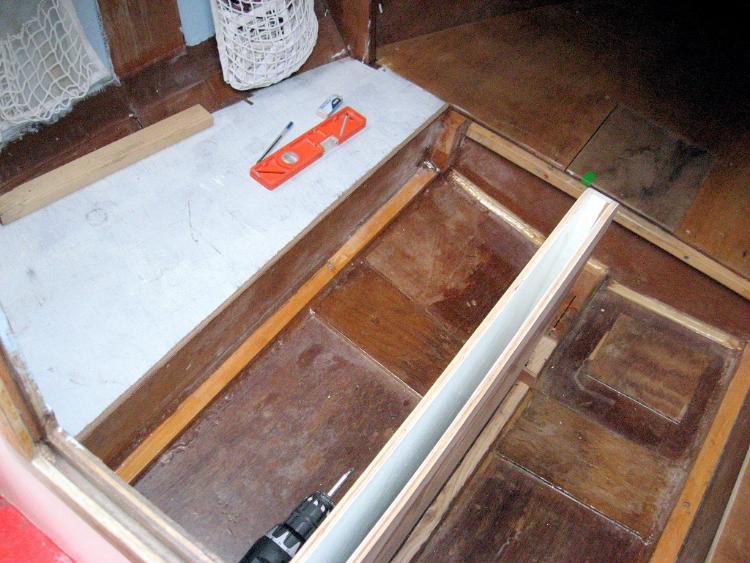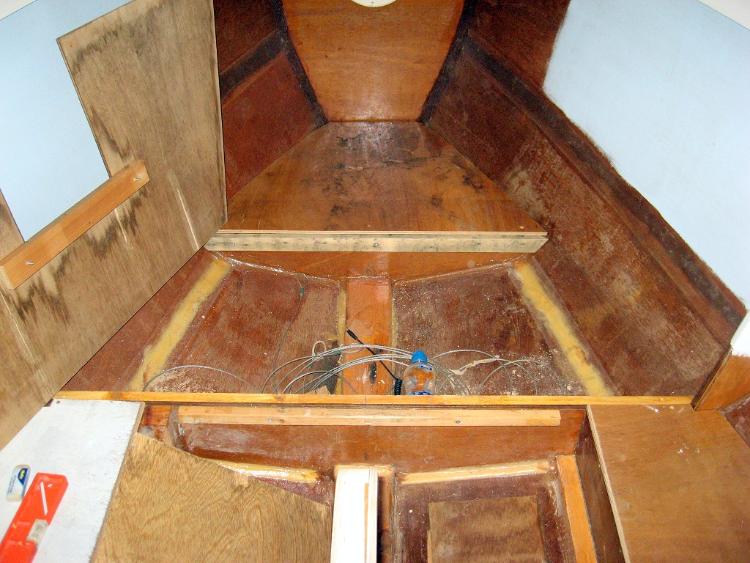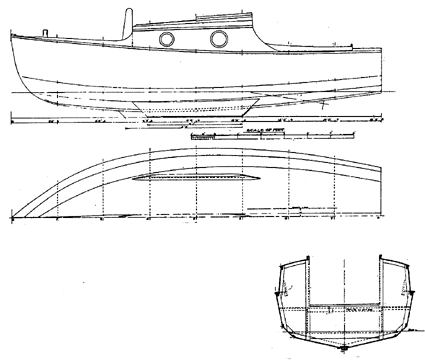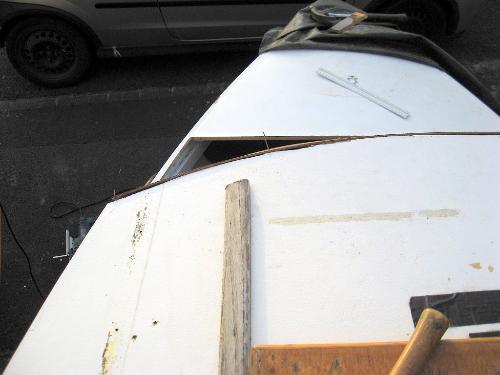MilliBee with a haircut?
1 ...
45678910
... 17
1 ...
45678910
... 17
|
|
We all know its easy to build a boat by following specific lengths and angles in a design....but marking new angles on an existing boat is really tricky.
There are no convenient horizontal or vertical edges to measure from on MilliBee. The cockpit seats are horizontal (well they should be) but that only helps marking the bulkhead and anyway the seats are too far away from the angle to be marked. Inside the cabin everything is at a weird angle.......but by sheer chance I picked up a random ply offcut and a light bulb in my head flickered: Take an offcut from the corner of a sheet of ply (yes they are worth keeping  )....that will be a reliable 90 degrees. Some simple trigonometry gives the base width and height of a triangle with the required 32 degree angle...all good so far but how do I hold the triangle in the right place? )....that will be a reliable 90 degrees. Some simple trigonometry gives the base width and height of a triangle with the required 32 degree angle...all good so far but how do I hold the triangle in the right place?
Just run a cleat across the gunnels - she was built with equal halves and accurate frames so a line joining the gunnels should be "level". Clamp the triangle to the cleat:  Draw 2 lines on the bulkhead and join them with a ruler. There you go an accurate 32 degrees from "horizontal" - a dead simple jig that is reusable along the length of the cabin, port and starboard. -Paul PS: The offcut was probably from a bulkhead frame nudged close to the corner of a sheet - we only need to mark the 2 ends of the triangle hypotenuse on the bulkhead because we can join them accurately with a ruler. So any corner offcut can be used, the corners are manufactured accurately at 90 degrees and if you can remember the Maths O-level days that makes the trigonometry easy (ask if you want help). |
|
|
This post was updated on .
Another lovely sunny day at HadleyVille, yesterday a lot of hard work cutting the floor to access around the centreboard case and heavy sanding of paint for later gluing. It's almost ready to glue in place.
Today I had a minor Eureka moment with the bunks. For those that don't know they were sort of parallel to the sides to give two permanent sleeping berths, which is quite traditional of course. But I realised I only need the full bunk overnight - at all other times it gets in the way. Ten minutes with a jig-saw produced this:  See how the old bilge cases support the seating. So much more room and 3 seating positions around the new centreboard case which will double up as a table. It's probably the best change I have made to her since starting the build in Jan 2002! For sleeping cleats along the bilge case and centreboard case will support a removable bunk:  Also more stowage forward, the floor cut so that either half can be removed (Al's idea I think):   Lots of space but I think I will strengthen the floor by doubling up the 6mm for protection when towing loaded with heavy tins. She really needs weight forward so there is double benefit. -Paul |
|
|
In reply to this post by Paul H (admin)
The Temperature Gods have smiled so I glued the centreboard case into the hog over the weekend - she will float again now!
The pivot bolt is an inch or two below the waterline (unless I move it after sea trials) and one thought is a vertical pocket sealing around it but open at the top, to allow all surfaces to dry out when on land. I'd like to know how you seal your centreboard pivot bolts? many thanks Paul |
|
|
Paulie
I use a stainless bolt with a part un-threaded shank and cut off any excess, including the thread, to suit. then I fix a small wooden pad each side of the pivot hole. One side has a blind ended hole to match and is set and sealed outside the case in epoxy - forever; and painted throughout. The pad on the other side is recessed to take the bolt head and has a couple of (?three/four) screw holes. This 'cover' is also treated to make it waterproof, but is only held in place by the screws, (you will probably need a centrally holed thickening pad stuck to the case to properly take the screw threads and epoxy the holes to preserve them). Obviously the bolt forms the pivot; leave the head on, as it gives you something to grab when extracting it. I close the cover over the head with silicone sealant, or similar and screw it down. Put the opening side where you can get at it; if for instance, you are right-handed and the pivot is down below, you will be crouching down, facing aft as you struggle, so set it up to port. Trying to see if the centreboard is in the right position to get the bolt into place can be fun too - draw a cross on the board, centred on the pivot hole, so that you can chase down the lines to locate it correctly. Make sense? CW |
|
|
CW,
Yes that makes sense - it's a neat solution. Do both pockets eventually dry out on land? I'd be concerned they trapped water forever. cheers -Paul |
|
|
When I built my Aber, I did something similar to Chris. The pivot is a piece of 5/8" bronze rod that goes straight through the case, ply doublers on each side and the board itself. The rod is slightly shorter than the total hole length and it is held in place with a lump of normal old fashioned putty at each end to seal the holes. Finally, a ply pad is screwed over each side. This does not leak and the pivot could be removed from either side if the need arises.
David. |
|
|
In reply to this post by Paul H (admin)
Yup Paulie
I'm sure they do dry out - unless they are kept on a mooring, boats spend infinitely more time waiting for us to take them 'swimmies' than they do actually in the water. If keeping a boat out of the water for just a few months, allows it to shed all those little H2O molecules from its epoxy micro-pores, then a visible hole should be a piece of cake, no? I use two part polyurethane paint anyway, as you know and although the holes are almost impossible to properly inspect inside the case, to the best of my knowledge, none of the three (three?!?) boats I have this arrangement on, have any problem.... "Just came away in me 'and Guv!" I agree with David that being able to open either side has it's advantages - you can check the condition of the holes much more completely; better lighting and in-depth perception than the caves I have created. Also in extremis, you can "knock the b*gger through" As opposed to having to pull it out by its ears Christo the W |
|
|
Chris, David,
Thanks - I found a stainless coach bolt in the shed that is so long it won't have any threads when trimmed to the correct length. It is only 10mm though, strong enough but has anyone seen excessive wear on a board using a 10mm pivot instead of 12mm or higher? cheers Paul |
|
|
Regarding sealing the ends of the pivot, I pretty much do a combination of David and Chris's methods.
Just plain rod of whatever material seems appropriate, e.g. Katie being so petite has aluminium, with end covers screwed in place and sealed with silicone or whatever is lying around the garage. I have been known to drill oversized holes which I then fill with thickened epoxy and then drill to the correct size creating a bush for the rod to bear on. Paulie, the 10mm bolt will probably (?) be strong enough, but a bigger diameter will increase the bearing area, spreading the load on the casing, and board preventing the hole getting too big and oval. Were you planning to put in any kind of bush? |
|
|
Graham,
I'm a tad cautious about using a bush - the pivot is 100mm above the hull and when fully vertical the board has 200mm inside the hog/case and at least 3ft in the water. The initial plan was to get the board as deep as possible and it just so happens the Enterprise has similar dimensions and is the same length as MilliBee. The stress on the bolt is likely to wear the board hole slightly until it can twist enough for the hog/case to take the full load and prevent any further twisting. So perhaps a loose fitting bush is what I want, although I don't have any suitable material. There is scope to restrict the angle of the board or even move the pivot higher after we have done sea trials. cheers Paul |
|
|
Excellent use of metric/imperial measurements to suit the occasion there.
I would caution against a wobbly board. We've got one on a scow at the Ancient & Vulnerable and it is very disconcerting to hear that loud clunk when going about. It also tends to rattle around every time someone makes wash when you are moored. A tip from Phil Oxborrow is to use old CDs as shims to pack out the space between board and case. I'm sure you could spare some from your Barry Manilow collection. |
|
|
In reply to this post by Paul H (admin)
Just thought I would add a warning comment re. the above quote from a previous post on this thread. A friend of mine who is now close to launching his 10m LOA home built yacht purchased a lot of sheets of best quality marine plywood from a well known supplier of boat building timber. He marked and cut out his panels measuring from two adjacent edges of each sheet. Yes, you guessed it - after cutting up all the sheets he realised that the manufactured corner was not a right angle - it was close enough not to be obvious but far enough out that nothing fitted properly. John |
|
|
This post was updated on .
In reply to this post by Chris Waite
I stumbled over these classic lines, the Yachting Monthly Senior:
 With the tabernacle on the roof, over the arch, those lines might work for MilliBee ? Similar to the existing cabin at the main bulkhead, but much steeper roof towards the front and shorter. Any comments chaps? -Paul |
|
|
'Course they'd work Paulie
Just depends if you want a traditional 'Yachting World Senior' cabin, or a 'Lynx 16' stealth bomber cabin, or a hard-chine, quasi 'Collective Spirit' cabin. Decisions, decisions CW |
|
|
In reply to this post by Paul H (admin)
Think the Lynx is better suited toa more modern angular look personally.
On 25 Apr 2013, at 00:05, adminHBBR [via UK HBBR Forum] wrote: I stumbled over these classic lines, the Yachting World Senior: |
|
|
Tim,
I have to disagree Sir! The more I look at the Yachting Monthly Senior the more I like her. She has classic lines and so much style, neatly woven into useful design features. Her sheer line is similar to Paul Fisher's classic curve on the Lynx and a YMS style cabin can work well. Here is a rough cut and paste:  If I wanted to build a bigger boat, the YMS would be a serious contender. -Paul |
|
|
Agreed, so don't muck about with it. Just get some ply and start building. plans available from Paul Fisher. YW Senior You know you want to. |
|
|
I have looked at the YM Senior on the Selway Fisher website many times and there is a lot that I like about it. It is big enough to be useful without being too big or heavy and I really like the lines. I have even gone as far as parting with a fiver to obtain the CD of the original plans from the Eventide Owners' Group. To my mind it would be a whole lot better as a gaff cutter, but that is another matter. One day, perhaps?
David. |
|
|
I very nearly bought one of these many years ago. I went to look at it (on a farm somewhere near Carn Brea), where it was sitting on a massive trailer that had been made from one of those big cable trailers used by the electricity board. I concluded it was just a bit small for what I had in mind, so ended up buying a wreck of a 1920's gaff cutter and spending 5 years restoring it.
In many ways I wish I'd bought that little senior, as it was a pretty little boat. It was only really the lack of headroom in the cabin that put me off, but now I'd happily live with that restriction. |
|
|
In reply to this post by Paul H (admin)
It was a lovely day for working outside, so the jigsaw was put to good use. Think "creative artwork" rather than engineering....I dived in with a curved front in mind, removed the flat front panel then experimented bending 4mm ply until I got a pleasing curve that I pencilled onto the roof as a cutting line.
After a bit of trial and error the curve bends back about 7in, previously dead flat. Here is a shot from above, notice how all the curves blend together in a balanced way. Previously the flat front clashed with all the curves - I never really liked it.  This shot shows that I don't need air conditioning! Only the port side is shaped, but already I'm very pleased how the front is much "softer" than before and more streamlined.  The balance is better, nearly 10% less side area. 
When I have a good curve I'll make a pattern and move the whole front aft about 9-10 inches which I think will balance the foredeck and cabin better as per the YMS. Then in the Autumn drop the roof 2 or 3 inches. The foredeck extension will be 2 lots of 4mm laminated, strong like the original but I'm not sure how to support it yet. I'm very pleased with the results so far. -Paul |
«
Return to General Discussion
|
1 view|%1 views
| Free forum by Nabble | Edit this page |


